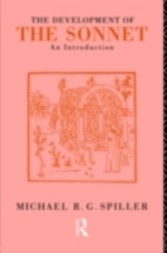
The Development of the Sonnet

von: Michael R. G. Spiller
Routledge, 1992
ISBN: 9780203401507
Sprache: Englisch
255 Seiten, Download: 2663 KB
Format: PDF, auch als Online-Lesen
5 THE FORTUNATE ISLES: THE SONNET MOVES ABROAD
For more than sixty years after the death of Petrarch, the sonnet remained the possession of the Italian language and culture, and did not become established in other European countries until the sixteenth century, almost a century and a half from Petrarch’s death in 1374. The reasons why things fail to happen in literature are hard to find, but a mystery there certainly is, why a form which continued to be popular in the most prosperous and cultivated country in Europe, backed by the authority of a writer who, if he owed his reputation mainly to his Latin works, was nevertheless widely read and imitated for his vernacular ones, had to wait so long for cultivation elsewhere. From the two nonItalian writers who first made contact with the sonnet, one can suggest— no more than that—why the sonnet did not at once transplant. These are Geoffrey Chaucer (1340–99) who translated a sonnet of Petrarch into English, but not into sonnet form, and the Marqués de Santillana, Inigo Lopez de Mendoza (1398–1458), who some time between 1438 and his death wrote forty-two sonnets in Spanish, avowing in the title of the collection that they were ‘sonetos fechos al italico modo’—sonnets made in the Italian style. Chaucer having declined to use the sonnet form, the Marqués has the credit of writing the first sonnet outside Italy, sixty years after Petrarch’s death. Then again a lull, and not until the 1520s did the sonnet become established in Britain, France and Spain. Chaucer’s encounter with Petrarch’s Rime is limited to the translation of one sonnet, ‘S’amor non è, che dunque è quel ch’io sento?’ (Rime 132), in the course of the first book of his Troilus and Criseyde (11. 400–20). When Troilus is aware that he is affected powerfully by Criseyde, he speaks a version of one of Petrarch’s self-realisations, probably written (in its final version) by Petrarch about 1366:
If no love is, O God, what fele I so?
And if love is, what thing and which is he?
If love be good, from whennes cometh my woo?
If it be wikke, a wonder thynketh me,
When every torment and adversite
That cometh of hym, may to me savory thinke,
For ay thurst I, the more that ich it drinke.
And if that at myn owen lust I brenne,
From whennes cometh my wailing and my pleynte?
If harm agree me, whereto pleyne I thenne?
I noot, ne whi unwery that I feynte.
O quike death, o swete harm so queynte,
How may of the in me swich quantite,
But if that I consente that it be?
And if that I consente, I wrongfully
Compleyne, Iwis. Thus possed to and fro,
Al stereless within a boot am I
Amydde the see, betwixen windes two,
That in contrarie stonden ever mo.
Allas! what is this wondre maladie?
For hete of cold, for cold of hete, I dye.
Chaucer’s three seven-line stanzas in rhyme-royal (ABABBCC) are taken from Petrarch’s single sonnet 132:
S’amor non è, che dunque è quel ch’io sento?
Ma s’egli è amor, per Dio, che cosa e quale?
Se bona, ond'è l’effetto aspro mortale?
Se ria, ond’è si dolce ogni tormento?
S’a mia voglia ardo, ond’è ‘l pianto e lamento?
s’a mal mio grado, il lamentar che vale?
O viva morte, o dilettoso male,
come puoi tanto in me s’io nol consento? Et s’io’l consento, a gran torto mi doglio.
Fra si contrari venti in frale barca
mi trovo in alto mar senza governo,
si lieve di saver, d’error si carca,
ch’i’medesmo non so quel ch’io mi voglio,
e tremo a mezza state, ardendo il verno.
One of Petrarch’s ‘sighs’, the /I/ represented as a confusion of perceptions and feelings, has been transferred to a character in a narrative poem who is, dramatically, at just such a point as Petrarch might have been at the start of his adoration of Laura.







